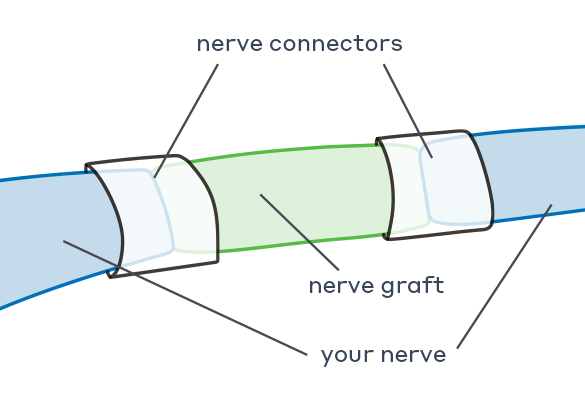surgical nerve repair options for cuts
If a nerve is cut, a space or gap is created in the nerve, making it impossible for the signal to get through properly. No signal means a loss of function, which may mean loss of feeling (numbness) or loss of the ability to move the affected area. Think of your TV plugged into the wall. If you cut the cord supplying power, the TV won’t turn on. Nerves are like wires, and a cut or severed nerve is as if you cut the electrical cord—electricity can no longer get through.
how is a nerve cut repaired?
A cut nerve will require surgical nerve repair to reconnect and bridge the gap between the two nerve ends to allow the nerve to regenerate and restore the lost function. If left unrepaired, a neuroma can develop and these can be extremely painful. Nerves must be repaired with no tension on the nerve. If the nerve ends are close together and the tissue is healthy, a surgeon may use a technique called direct repair to suture the ends directly together. Or they may use a small tube or connector to help line up the nerve ends. But in many cases, a direct repair will not be possible because there is too big of a gap. In this case your surgeon will likely recommend one of two options as a bridging material to provide the appropriate structure for the nerve to regenerate—an allograft nerve or autograft nerve. Understanding the difference between these two options can help you better decide which option may be best for you. For example, with an autograft, you will be faced with a secondary surgical site.

A nerve cut is often caused by a traumatic injury, or previous surgery. Learn more about what may cause a nerve to be cut. Learn more
A nerve allograft can be used to bridge the gap caused by your injury, enabling the nerve to heal and repair itself. And it’s been shown to result in a similar ability to feel or move after surgery as autograft nerve, without the need for a second surgical site.1 Nerve tissue is donated just like other tissue or organs and undergoes rigorous screening for diseases. The nerves are cleaned and sterilized by Axogen using a patented, proprietary process to ensure the highest quality of nerve graft possible. The process removes cells from the tissue while leaving the normal, healthy nerve structure intact so you don’t need immunosuppression medication like with organ transplantation.
Using autograft nerve involves surgically removing a sensory nerve from another part of your body to repair your damaged nerve. The most common site is the sural nerve in your leg. Depending on the extent of your nerve damage, your surgeon may recommend this procedure. But it’s important to understand that this can result in long‑term side effects at the nerve harvest site:
- 92.5% of patients had long-term numbness (sensory deficits)2
- 22.9% of patients had chronic pain, which can make it
difficult to return to work or regular activities2 - 28.5% of patients had sensory symptoms, e.g., tingling,
cold intolerance, irritating sensations2 - Some patients experience short- or long-term decreased
movement in their leg3
| allograft nerves | autograft nerves | |
| what is it? | Donated nerve tissue that is processed and sterilized. | A nerve is taken from another part of your body—most often the leg. |
| does it require a second incision during surgery? | No | In most cases |
| will the results be the same?* | 52.6–86% meaningful recovery rate3 | 50.5–81.6% meaningful recovery rate3 |
*These rates are considered to be equivalent. There is no statistical difference between them.

could I have nerve damage?
Explore how nerve damage can happen and learn about how different nerves work throughout the body.
Your doctor will provide recommendations, but read on to learn about various repair options for different types of nerve damage.
for cut nerves
direct repair
Nerves must be repaired with no tension on the nerve. If the nerve ends are close together and the tissue is healthy, a surgeon may stitch the ends directly together.

nerve autograft
A nerve from another area of the body is surgically removed and used to bridge the gap in the injured peripheral nerve to guide the healing nerve fibers as they grow. The donor site from the transplant is left with a permanent loss of function. The donor site is selected carefully to minimize the impact.
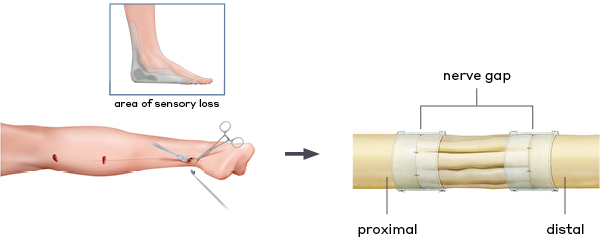
processed nerve allograft
A human peripheral nerve is donated through the tissue donation process. It undergoes rigorous screening, processing to clear and remove cells, and is sterilized before use. Like the nerve autograft, it is used to bridge a gap in a peripheral nerve to guide the healing nerve fibers as they grow.
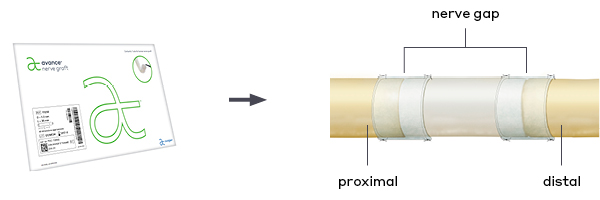
connector-assisted repair®
Connector-assisted repair allows the surgeon to use a small tube to line up the nerve ends when doing a direct, small gap (< 5 mm), allograft or autograft repair.
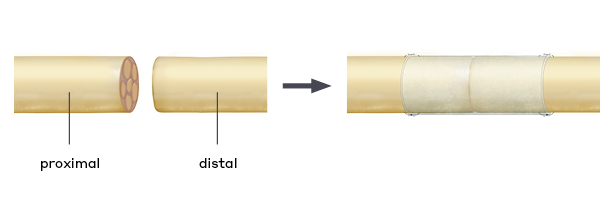
conduit (hollow tube)
A conduit (hollow tube) is made of collagen or synthetic material and may be used to bridge a gap in a peripheral nerve. It doesn’t have an internal structure to guide nerve fibers, and data show it should only be used for very tiny gaps (5 mm and less) between the nerve ends.4
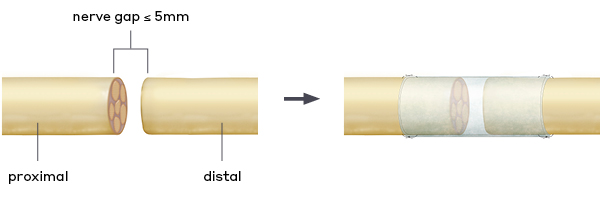
nerve transfer
A surgeon may transfer a functioning nerve to take over an area that has lost function. The transferred nerve delivers signals to the damaged nerve end. However, this means that there is a loss or a reduction of function from the donor site. Gaining function in the transfer area generally outweighs the loss of function from the donor nerve, and is usually done to ensure muscles don’t atrophy.

nerve cap
A nerve cap is used to reduce the formation of neuromas and to protect and isolate the nerve end from mechanical stimulation and surrounding tissue. Without the protective surrounding of the nerve cap, the nerve end could still be irritated and send pain signals to the brain.
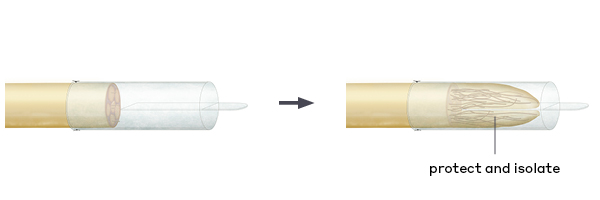
healthy peripheral nerves allow us to

references
- Safa B, et al. Peripheral nerve repair throughout the body with processed nerve allografts: results from a large multicenter study. Microsurgery. 2020;40(5):527-537.
- Ducic I, et al. Chronic postoperative complications and donor site morbidity after sural nerve autograft harvest or biopsy. Microsurgery. Sep 2020;40(6):710-716.
- Data on file.
- Weber RA, et al. A randomized prospective study of polyglycolic acid conduits for digital nerve reconstruction in humans. Plast Reconstr Surg. Oct 2000;106(5):1036-1048.
